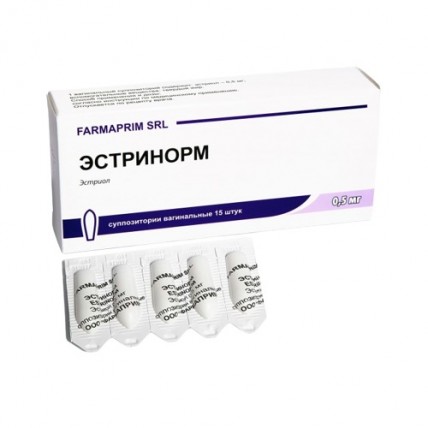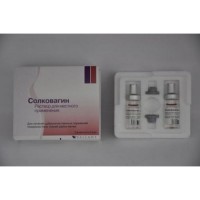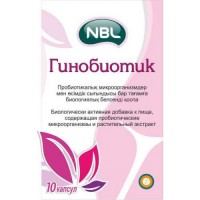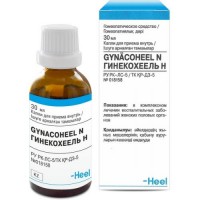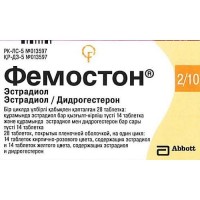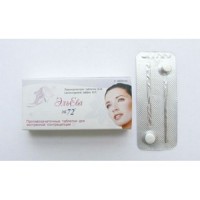ESTRINORM (Estriol) 0.5 mg, 15 Ovules
- $28.00
One suppository contains
Intravaginal administration of estriol ensures optimal bioavailability at its site of action. Estriol is also absorbed and enters the systemic circulation, which is manifested by a rapid increase in the concentration of unbound estriol in the blood plasma. The maximum concentration in blood plasma is observed 1-2 hours after administration. In plasma, almost all (90%) estriol is associated with albumin and, unlike other estrogens, is practically not associated with sex hormone-binding globulin. The metabolism of estriol consists mainly in the transition to the conjugated and unconjugated state during the entero-hepatic circulation. Estriol is mainly excreted via the kidneys in the form of conjugates. A small part of estriol (2%) is excreted through the intestines, mainly in unconjugated form. The elimination half-life after vaginal application is approximately 6-9 hours.
Estriol is an analogue of the natural female hormone. It replenishes estrogen deficiency in postmenopausal women and relieves postmenopausal symptoms. Estriol is most effective in the treatment of genitourinary disorders. In the case of atrophy of the mucous membrane of the lower urinary tract, estriol contributes to the normalization of the epithelium of the urinary tract and the restoration of normal microflora and physiological pH in the vagina. As a result, it increases the resistance of urinary tract epithelial cells to infection and inflammation, reduces complaints such as pain during intercourse, dryness, itching in the vagina, reduces the likelihood of vaginal infections and urinary tract infections, promotes normal urination and prevents urinary incontinence. Unlike other estrogens, estriol has a short-term effect because it has a short retention time in the nuclei of endometrial cells. It is assumed that a single administration of a daily dose does not cause endometrial proliferation. Therefore, no progestogen cycling is required and no withdrawal bleeding occurs. In addition, estriol has not been shown to increase mammographic density.
Intravaginally.
Suppositories should be inserted into the vagina at night before going to bed.
In the treatment of atrophy of the mucous membrane of the lower urinary tract:
1 suppository per day during the first weeks, followed by a gradual decrease in dose, depending on the relief of symptoms, until a maintenance dose is reached (maximum - 1 suppository twice a week).
Pre- and postoperative therapy of postmenopausal women with surgical interventions by vaginal access:
1 suppository per day for 2 weeks before surgery; 1 suppository twice a week for 2 weeks after surgery.
For diagnostic purposes with unclear atrophic results of a vaginal smear:
1 suppository every other day for a week, until the next smear.
Suppositories must be administered intravaginally at bedtime.
If the next dose of the drug was missed, it should be administered immediately, unless the patient remembers it on the day of the next dose. In this case, the missed dose should be omitted and the drug should be continued according to the usual scheme, without making up for the previously missed dose. Do not use two suppositories on the same day.
When starting or continuing treatment for postmenopausal symptoms, the lowest effective dose should be used for the shortest possible time. In women not receiving HRT, or women who are switching from a continuous oral combination drug for HRT, treatment with the drug can be started on any day. Women who are switching from a cyclic HRT regimen should start treatment with the drug one week after stopping HRT drugs.
According to the literature review and pharmacovigilance data, the following adverse reactions were observed:
- fluid retention in the body
- itching at the injection site
- tenderness, soreness of the mammary glands, spotting, cervical discharge
These adverse reactions are usually short-lived and transient, but at the same time may indicate the use of too high a dose.
Side effects in connection with treatment with estrogen-progestagen combination:
- acyclic spotting, breakthrough bleeding, menorrhagia
- benign and malignant estrogen-dependent tumors, such as endometrial cancer
- diseases of the gallbladder
- skin and subcutaneous disorders: chloasma, erythema multiforme, erythema nodosum, hemorrhagic purpura
- possible dementia at age 65 and older
- the risk of developing breast cancer (in women receiving combined estrogen-progestogen therapy for 5 years or more, the risk of developing breast cancer increases by 2 times, the level of risk depends on the duration of admission; any increased risk is significantly lower in patients receiving therapy exclusively estrogen, as opposed to patients taking estrogen-progestogen combination therapy)
- ovarian cancer (long-term use of HRT exclusively with estrogen or an estrogen-progestogen combination slightly increases the risk of developing ovarian cancer)
- venous thromboembolism (may increase by 1.3-3 times the risk of developing venous thromboembolism, i.e. deep vein thrombosis, pulmonary embolism)
- ischemic heart disease, incl. myocardial infarction (the risk of developing coronary heart disease is slightly increased in patients over 60 years of age receiving combined estrogen-progestogen HRT)
- ischemic stroke (the risk of ischemic stroke is increased by 1.5 times in patients receiving estrogen therapy alone or taking estrogen-progestogen combination therapy)
- hypersensitivity to the active substance or to any of the excipients of the drug
- pregnancy, suspected pregnancy, breastfeeding
- diagnosed or suspected breast cancer
- diagnosed or suspected estrogen-dependent tumors such as endometrial cancer
- vaginal bleeding of unknown etiology
- untreated endometrial hyperplasia
- venous thrombosis at present and in history (deep venous thrombosis, pulmonary embolism)
- known thrombophilic disorders (for example, deficiency of protein C, protein S or antithrombin)
- active or recent thromboembolic arterial disease (eg, angina pectoris, myocardial infarction)
- liver disease in the acute stage or a history of liver disease, before the normalization of liver function tests
- porphyria
In clinical practice, there has been no interaction between the drug Estrinorm and other drugs.
Estrogen metabolism may be increased when used in combination with compounds that induce enzymes involved in drug metabolism, especially cytochrome P450 enzymes, such as anticonvulsants (eg, phenobarbital, phenytoin, carbamazepine) and antimicrobials (eg, rifampicin, rifabutin, nevirapine and efavirenz) can induce estrogen metabolism.
Ritonavir and nelfinavir, known as strong inhibitors, show inductive properties when taken with steroid hormones.
St. John's wort preparations can increase the metabolism of estrogens.
The clinical effect of increasing estrogen metabolism can be manifested by a decrease in the effectiveness of Estrinorm, and uterine bleeding.
Estrinorm may enhance the pharmacological effect of corticosteroids, succinylcholine, theophyllines and troleandomycin. If necessary, the dosage should be reduced. Estrinorm may change the effectiveness of oral anticoagulants.
Treatment of postmenopausal symptoms with HRT should only be started for symptoms that adversely affect quality of life. In all cases, a thorough assessment of the risks and benefits of treatment should be carried out at least once a year. HRT should only be continued for a period of time when the benefits outweigh the risks.
Data on the risks associated with HRT in the treatment of premature menopause are limited. The risk-benefit ratio among younger women may be more favorable than among older women.
Medical examination/observation
Before starting or resuming HRT, it is necessary to establish a detailed individual and family history. Based on the history, contraindications and warnings for the use of the drug, it is necessary to conduct a clinical examination, including examination of the pelvic organs and mammary glands. During treatment, it is recommended to conduct periodic medical examinations, the frequency and nature of which are individual, but at least once a year. Women should be aware of the need to inform the doctor about changes in the mammary glands, if they occur. Examinations, including mammography, must be carried out in accordance with generally accepted examination standards.
Conditions requiring monitoring
If present, occurred earlier and / or worsened during pregnancy or previous hormonal observation of any of the following conditions, the patient should be under constant observation. It should be borne in mind that these conditions may recur or worsen during treatment with Estrinorm. This applies to the following conditions:
- fibroids (uterine fibroids) or endometriosis
- past thromboembolic disorders or the presence of risk factors for such disorders
- the presence of risk factors for estrogen-dependent malignant tumors (breast cancer among relatives of the 1st degree of relatives)
- hypertension
- liver disorders (eg, liver adenoma)
- diabetes mellitus with or without a vascular component
- cholelithiasis
migraine or (severe) headache
- systemic lupus erythematosus
- history of endometrial hyperplasia
- epilepsy
- asthma
- otosclerosis
Reasons for immediate discontinuation of therapy
Therapy should be discontinued if a contraindication is identified and/or if the following conditions occur:
- jaundice and/or deterioration of liver function
- a significant increase in blood pressure
- recurrence of migraine headache
- pregnancy
endometrial hyperplasia and carcinoma
To prevent stimulation of the endometrium, the daily dose should not exceed 1 suppository (0.5 mg of estriol). It should not be used for more than 4 weeks.
Mammary cancer
The risk of developing breast cancer in women receiving estrogen-progestogen or estrogen HRT depends on the duration of this therapy.
The risk of developing breast cancer increases in women who take these drugs for several years, but returns to baseline less than five years after stopping treatment.
Combined estrogen-progestogen therapy:
The results of studies indicate an increased risk of developing breast cancer in women taking estrogen and progestogen for HRT for more than 3 years.
Estrogen-only therapy:
- The WHI study found no increased risk of breast cancer in hysterectomized women receiving estrogen-only HRT. There is a slight increase in the risk of developing breast cancer, which is significantly lower than in those taking estrogen-progestogen therapy.
- HRT may increase mammogram density. This can make radiographic detection of breast cancer difficult. The likelihood of developing increased mammogram density was lower in those study subjects who received estriol, in contrast to other patients who received other estrogens.
It has been found that taking estriol, unlike other estrogens, does not lead to an increased risk of developing breast cancer.
ovarian cancer
Ovarian cancer develops much less frequently than breast cancer. The risk of developing ovarian cancer is slightly increased as a result of long-term use (at least 5-10 years) of estrogen for HRT.
Venous thromboembolism
- HRT is associated with a 1.3-3 times increase in the risk of developing venous thromboembolism (VTE), i.e. deep vein thrombosis or pulmonary embolism. VTE is more likely during the first year of HRT than later. No such risk is known for Estrinorm.
- In the presence of thromboembolic conditions in history, there is an increased risk of developing VTE. The use of HRT may increase the risk of relapse; therefore, HRT is contraindicated in these patients.
- The following factors may increase the risk of VTE: estrogen use, older age, major surgery, prolonged immobilization, obesity (body mass index >30 kg/m2), pregnancy/postpartum period, systemic lupus erythematosus, cancer. After surgery, special attention should be paid to preventive measures to prevent VTE. In cases where prolonged immobilization is unavoidable after a planned operation, in particular after abdominal surgery or orthopedic surgery on the lower extremities, if possible, it is necessary to provide for a temporary cessation of HRT 4-6 weeks before the operation. Treatment should not be resumed until the patient has fully recovered.
- If Estrinorm is taken according to the indications "Pre- and postoperative therapy in postmenopausal women with vaginal surgery", attention should be paid to the prophylactic treatment of thrombosis.
Women who do not have a history of VTE, but who have close relatives with a history of thrombosis, are recommended to undergo fluoroscopy (only a part of thrombophilic defects are determined by fluoroscopy). If serious abnormalities other than thrombosis are detected, for example, deficiency of antithrombin, protein S, protein C, or a combination of abnormalities), HRT is contraindicated.
- Women who are already on anticoagulant treatment require a thorough benefit/risk analysis of HRT.
- If VTE develops after the start of therapy with Estrinorm, treatment should be discontinued. Patients should be advised to seek immediate medical attention in the event of potential symptoms of thromboembolism (eg, painful leg swelling, sudden chest pain, shortness of breath).
Ischemic heart disease (CHD)
There are no data indicating protection against the development of myocardial infarction in women with or without coronary artery disease who received estrogen-progestogen combinations or estrogen alone during HRT.
Combined estrogen-progestogen therapy
- The relative risk of developing coronary artery disease increases with estrogen-progestogen combination HRT and increases with age.
estrogen therapy
- There is no evidence of an increased risk of CHD in hysterectomized women taking estrogen alone.
Ischemic stroke
The risk of ischemic stroke in combination therapy with estrogen-progestogen and estrogen monotherapy increases by 1.5 times. The relative risk does not change with age or time since the onset of menopause. However, the overall risk of stroke in women receiving HRT increases with age, since the initial absolute risk of stroke is significantly age-dependent.
Other states
- Estrogens can cause fluid retention, and therefore patients with impaired renal function and cardiovascular insufficiency should be under close medical supervision.
- Estriol is a weak inhibitor of gonadotropin and does not have other significant effects on the endocrine system
- HRT does not improve cognitive function. However, some results suggest an increased risk of possible dementia in women who began receiving long-term combination therapy or estrogen HRT after the age of 65 years.
- Estrinorm is not indicated for contraception.
Pregnancy and lactation
Estrinorm is only indicated for the treatment of postmenopausal women (natural or post-surgical).
Estrinorm is contraindicated during pregnancy. In the event of pregnancy during therapy with Estrinorm, treatment should be discontinued immediately. The results of most of the epidemiological studies conducted to date regarding the unintended effects of estrogens on the fetus indicate the absence of teratogenic or fetotoxic effects.
The drug is not recommended during breastfeeding. Estriol is excreted in breast milk and may reduce milk production.
Features of the effect of the drug on the ability to drive a vehicle or potentially dangerous mechanisms.
Data on the effect of Estrinorm on the ability to drive a car or complex mechanisms is not enough.
Symptoms: an overdose of Estrinorm when administered vaginally is unlikely. However, in case of inadvertent ingestion of large doses in the gastrointestinal tract, nausea, vomiting and cessation of menstrual bleeding in women may develop.
Treatment: There is no specific antidote. If necessary, symptomatic treatment should be carried out.
Store in a dry, dark place at a temperature not exceeding 25˚C. Do not freeze.
Keep out of the reach of children!
Shelf life - 3 years
Do not use after the expiration date.
- Active ingredient: Estriol (Oestriol) 0.5 mg,
- Excipients: solid fat
Pharmacological properties
Pharmacokinetics
Intravaginal administration of estriol ensures optimal bioavailability at its site of action. Estriol is also absorbed and enters the systemic circulation, which is manifested by a rapid increase in the concentration of unbound estriol in the blood plasma. The maximum concentration in blood plasma is observed 1-2 hours after administration. In plasma, almost all (90%) estriol is associated with albumin and, unlike other estrogens, is practically not associated with sex hormone-binding globulin. The metabolism of estriol consists mainly in the transition to the conjugated and unconjugated state during the entero-hepatic circulation. Estriol is mainly excreted via the kidneys in the form of conjugates. A small part of estriol (2%) is excreted through the intestines, mainly in unconjugated form. The elimination half-life after vaginal application is approximately 6-9 hours.
Pharmacodynamics
Estriol is an analogue of the natural female hormone. It replenishes estrogen deficiency in postmenopausal women and relieves postmenopausal symptoms. Estriol is most effective in the treatment of genitourinary disorders. In the case of atrophy of the mucous membrane of the lower urinary tract, estriol contributes to the normalization of the epithelium of the urinary tract and the restoration of normal microflora and physiological pH in the vagina. As a result, it increases the resistance of urinary tract epithelial cells to infection and inflammation, reduces complaints such as pain during intercourse, dryness, itching in the vagina, reduces the likelihood of vaginal infections and urinary tract infections, promotes normal urination and prevents urinary incontinence. Unlike other estrogens, estriol has a short-term effect because it has a short retention time in the nuclei of endometrial cells. It is assumed that a single administration of a daily dose does not cause endometrial proliferation. Therefore, no progestogen cycling is required and no withdrawal bleeding occurs. In addition, estriol has not been shown to increase mammographic density.
Indications for use
- Hormone replacement therapy (HRT) for the treatment of lower genitourinary tract atrophy associated with estrogen deficiency
- Pre- and postoperative therapy of postmenopausal women in surgical interventions by vaginal access
Dosage and administration
Intravaginally.
Suppositories should be inserted into the vagina at night before going to bed.
In the treatment of atrophy of the mucous membrane of the lower urinary tract:
1 suppository per day during the first weeks, followed by a gradual decrease in dose, depending on the relief of symptoms, until a maintenance dose is reached (maximum - 1 suppository twice a week).
Pre- and postoperative therapy of postmenopausal women with surgical interventions by vaginal access:
1 suppository per day for 2 weeks before surgery; 1 suppository twice a week for 2 weeks after surgery.
For diagnostic purposes with unclear atrophic results of a vaginal smear:
1 suppository every other day for a week, until the next smear.
Suppositories must be administered intravaginally at bedtime.
If the next dose of the drug was missed, it should be administered immediately, unless the patient remembers it on the day of the next dose. In this case, the missed dose should be omitted and the drug should be continued according to the usual scheme, without making up for the previously missed dose. Do not use two suppositories on the same day.
When starting or continuing treatment for postmenopausal symptoms, the lowest effective dose should be used for the shortest possible time. In women not receiving HRT, or women who are switching from a continuous oral combination drug for HRT, treatment with the drug can be started on any day. Women who are switching from a cyclic HRT regimen should start treatment with the drug one week after stopping HRT drugs.
Side effects
According to the literature review and pharmacovigilance data, the following adverse reactions were observed:
- fluid retention in the body
- itching at the injection site
- tenderness, soreness of the mammary glands, spotting, cervical discharge
These adverse reactions are usually short-lived and transient, but at the same time may indicate the use of too high a dose.
Side effects in connection with treatment with estrogen-progestagen combination:
- acyclic spotting, breakthrough bleeding, menorrhagia
- benign and malignant estrogen-dependent tumors, such as endometrial cancer
- diseases of the gallbladder
- skin and subcutaneous disorders: chloasma, erythema multiforme, erythema nodosum, hemorrhagic purpura
- possible dementia at age 65 and older
- the risk of developing breast cancer (in women receiving combined estrogen-progestogen therapy for 5 years or more, the risk of developing breast cancer increases by 2 times, the level of risk depends on the duration of admission; any increased risk is significantly lower in patients receiving therapy exclusively estrogen, as opposed to patients taking estrogen-progestogen combination therapy)
- ovarian cancer (long-term use of HRT exclusively with estrogen or an estrogen-progestogen combination slightly increases the risk of developing ovarian cancer)
- venous thromboembolism (may increase by 1.3-3 times the risk of developing venous thromboembolism, i.e. deep vein thrombosis, pulmonary embolism)
- ischemic heart disease, incl. myocardial infarction (the risk of developing coronary heart disease is slightly increased in patients over 60 years of age receiving combined estrogen-progestogen HRT)
- ischemic stroke (the risk of ischemic stroke is increased by 1.5 times in patients receiving estrogen therapy alone or taking estrogen-progestogen combination therapy)
Contraindications
- hypersensitivity to the active substance or to any of the excipients of the drug
- pregnancy, suspected pregnancy, breastfeeding
- diagnosed or suspected breast cancer
- diagnosed or suspected estrogen-dependent tumors such as endometrial cancer
- vaginal bleeding of unknown etiology
- untreated endometrial hyperplasia
- venous thrombosis at present and in history (deep venous thrombosis, pulmonary embolism)
- known thrombophilic disorders (for example, deficiency of protein C, protein S or antithrombin)
- active or recent thromboembolic arterial disease (eg, angina pectoris, myocardial infarction)
- liver disease in the acute stage or a history of liver disease, before the normalization of liver function tests
- porphyria
Drug Interactions
In clinical practice, there has been no interaction between the drug Estrinorm and other drugs.
Estrogen metabolism may be increased when used in combination with compounds that induce enzymes involved in drug metabolism, especially cytochrome P450 enzymes, such as anticonvulsants (eg, phenobarbital, phenytoin, carbamazepine) and antimicrobials (eg, rifampicin, rifabutin, nevirapine and efavirenz) can induce estrogen metabolism.
Ritonavir and nelfinavir, known as strong inhibitors, show inductive properties when taken with steroid hormones.
St. John's wort preparations can increase the metabolism of estrogens.
The clinical effect of increasing estrogen metabolism can be manifested by a decrease in the effectiveness of Estrinorm, and uterine bleeding.
Estrinorm may enhance the pharmacological effect of corticosteroids, succinylcholine, theophyllines and troleandomycin. If necessary, the dosage should be reduced. Estrinorm may change the effectiveness of oral anticoagulants.
Special instructions
Treatment of postmenopausal symptoms with HRT should only be started for symptoms that adversely affect quality of life. In all cases, a thorough assessment of the risks and benefits of treatment should be carried out at least once a year. HRT should only be continued for a period of time when the benefits outweigh the risks.
Data on the risks associated with HRT in the treatment of premature menopause are limited. The risk-benefit ratio among younger women may be more favorable than among older women.
Medical examination/observation
Before starting or resuming HRT, it is necessary to establish a detailed individual and family history. Based on the history, contraindications and warnings for the use of the drug, it is necessary to conduct a clinical examination, including examination of the pelvic organs and mammary glands. During treatment, it is recommended to conduct periodic medical examinations, the frequency and nature of which are individual, but at least once a year. Women should be aware of the need to inform the doctor about changes in the mammary glands, if they occur. Examinations, including mammography, must be carried out in accordance with generally accepted examination standards.
Conditions requiring monitoring
If present, occurred earlier and / or worsened during pregnancy or previous hormonal observation of any of the following conditions, the patient should be under constant observation. It should be borne in mind that these conditions may recur or worsen during treatment with Estrinorm. This applies to the following conditions:
- fibroids (uterine fibroids) or endometriosis
- past thromboembolic disorders or the presence of risk factors for such disorders
- the presence of risk factors for estrogen-dependent malignant tumors (breast cancer among relatives of the 1st degree of relatives)
- hypertension
- liver disorders (eg, liver adenoma)
- diabetes mellitus with or without a vascular component
- cholelithiasis
migraine or (severe) headache
- systemic lupus erythematosus
- history of endometrial hyperplasia
- epilepsy
- asthma
- otosclerosis
Reasons for immediate discontinuation of therapy
Therapy should be discontinued if a contraindication is identified and/or if the following conditions occur:
- jaundice and/or deterioration of liver function
- a significant increase in blood pressure
- recurrence of migraine headache
- pregnancy
endometrial hyperplasia and carcinoma
To prevent stimulation of the endometrium, the daily dose should not exceed 1 suppository (0.5 mg of estriol). It should not be used for more than 4 weeks.
Mammary cancer
The risk of developing breast cancer in women receiving estrogen-progestogen or estrogen HRT depends on the duration of this therapy.
The risk of developing breast cancer increases in women who take these drugs for several years, but returns to baseline less than five years after stopping treatment.
Combined estrogen-progestogen therapy:
The results of studies indicate an increased risk of developing breast cancer in women taking estrogen and progestogen for HRT for more than 3 years.
Estrogen-only therapy:
- The WHI study found no increased risk of breast cancer in hysterectomized women receiving estrogen-only HRT. There is a slight increase in the risk of developing breast cancer, which is significantly lower than in those taking estrogen-progestogen therapy.
- HRT may increase mammogram density. This can make radiographic detection of breast cancer difficult. The likelihood of developing increased mammogram density was lower in those study subjects who received estriol, in contrast to other patients who received other estrogens.
It has been found that taking estriol, unlike other estrogens, does not lead to an increased risk of developing breast cancer.
ovarian cancer
Ovarian cancer develops much less frequently than breast cancer. The risk of developing ovarian cancer is slightly increased as a result of long-term use (at least 5-10 years) of estrogen for HRT.
Venous thromboembolism
- HRT is associated with a 1.3-3 times increase in the risk of developing venous thromboembolism (VTE), i.e. deep vein thrombosis or pulmonary embolism. VTE is more likely during the first year of HRT than later. No such risk is known for Estrinorm.
- In the presence of thromboembolic conditions in history, there is an increased risk of developing VTE. The use of HRT may increase the risk of relapse; therefore, HRT is contraindicated in these patients.
- The following factors may increase the risk of VTE: estrogen use, older age, major surgery, prolonged immobilization, obesity (body mass index >30 kg/m2), pregnancy/postpartum period, systemic lupus erythematosus, cancer. After surgery, special attention should be paid to preventive measures to prevent VTE. In cases where prolonged immobilization is unavoidable after a planned operation, in particular after abdominal surgery or orthopedic surgery on the lower extremities, if possible, it is necessary to provide for a temporary cessation of HRT 4-6 weeks before the operation. Treatment should not be resumed until the patient has fully recovered.
- If Estrinorm is taken according to the indications "Pre- and postoperative therapy in postmenopausal women with vaginal surgery", attention should be paid to the prophylactic treatment of thrombosis.
Women who do not have a history of VTE, but who have close relatives with a history of thrombosis, are recommended to undergo fluoroscopy (only a part of thrombophilic defects are determined by fluoroscopy). If serious abnormalities other than thrombosis are detected, for example, deficiency of antithrombin, protein S, protein C, or a combination of abnormalities), HRT is contraindicated.
- Women who are already on anticoagulant treatment require a thorough benefit/risk analysis of HRT.
- If VTE develops after the start of therapy with Estrinorm, treatment should be discontinued. Patients should be advised to seek immediate medical attention in the event of potential symptoms of thromboembolism (eg, painful leg swelling, sudden chest pain, shortness of breath).
Ischemic heart disease (CHD)
There are no data indicating protection against the development of myocardial infarction in women with or without coronary artery disease who received estrogen-progestogen combinations or estrogen alone during HRT.
Combined estrogen-progestogen therapy
- The relative risk of developing coronary artery disease increases with estrogen-progestogen combination HRT and increases with age.
estrogen therapy
- There is no evidence of an increased risk of CHD in hysterectomized women taking estrogen alone.
Ischemic stroke
The risk of ischemic stroke in combination therapy with estrogen-progestogen and estrogen monotherapy increases by 1.5 times. The relative risk does not change with age or time since the onset of menopause. However, the overall risk of stroke in women receiving HRT increases with age, since the initial absolute risk of stroke is significantly age-dependent.
Other states
- Estrogens can cause fluid retention, and therefore patients with impaired renal function and cardiovascular insufficiency should be under close medical supervision.
- Estriol is a weak inhibitor of gonadotropin and does not have other significant effects on the endocrine system
- HRT does not improve cognitive function. However, some results suggest an increased risk of possible dementia in women who began receiving long-term combination therapy or estrogen HRT after the age of 65 years.
- Estrinorm is not indicated for contraception.
Pregnancy and lactation
Estrinorm is only indicated for the treatment of postmenopausal women (natural or post-surgical).
Estrinorm is contraindicated during pregnancy. In the event of pregnancy during therapy with Estrinorm, treatment should be discontinued immediately. The results of most of the epidemiological studies conducted to date regarding the unintended effects of estrogens on the fetus indicate the absence of teratogenic or fetotoxic effects.
The drug is not recommended during breastfeeding. Estriol is excreted in breast milk and may reduce milk production.
Features of the effect of the drug on the ability to drive a vehicle or potentially dangerous mechanisms.
Data on the effect of Estrinorm on the ability to drive a car or complex mechanisms is not enough.
Overdose
Symptoms: an overdose of Estrinorm when administered vaginally is unlikely. However, in case of inadvertent ingestion of large doses in the gastrointestinal tract, nausea, vomiting and cessation of menstrual bleeding in women may develop.
Treatment: There is no specific antidote. If necessary, symptomatic treatment should be carried out.
Storage conditions
Store in a dry, dark place at a temperature not exceeding 25˚C. Do not freeze.
Keep out of the reach of children!
Shelf life - 3 years
Do not use after the expiration date.
